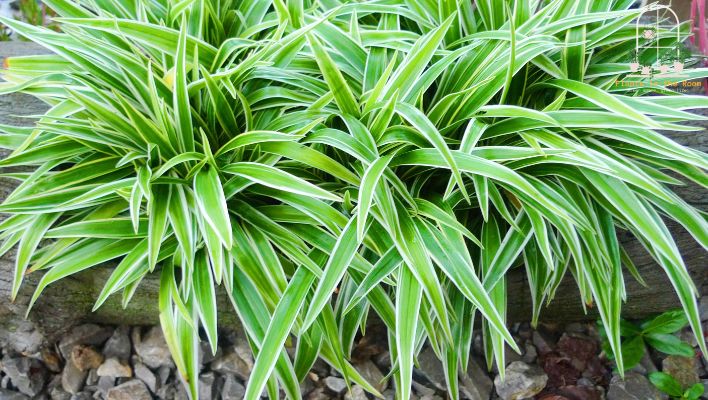This article covers the following areas –
- Introduction to Spider Plants
- Decorative Ideas Using Spider Plants
- Care for Your Spider Plant
- In Conclusion
A favorite among indoor gardeners, Spider Plants are aesthetically pleasing and beneficial in purifying indoor air. Let’s dive deep into how we can harness the beauty of this plant in home decor. In this article, I’ll talk about how the humble Spider Plant can add an elegant touch to your home decor.
Spider Plants are versatile houseplants that can be incorporated into home decor in various ways, including hanging basket displays, shelf arrangements, and table centerpieces. Their attractive, arching foliage and trailing ‘spiderettes’ provide a unique aesthetic appeal.
However, the beauty of using Spider Plants for home decor goes beyond the surface. Understanding different varieties, suitable display locations, complementing decor items, and essential plant care routines is vital to leverage their appeal fully. Let’s dive deeper into this article to explore a comprehensive guide on home decor ideas with Spider Plants.
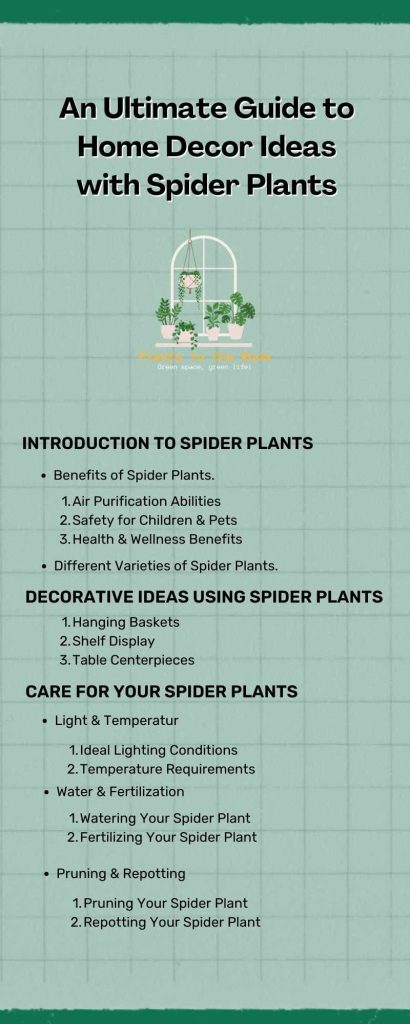
Introduction to Spider Plants
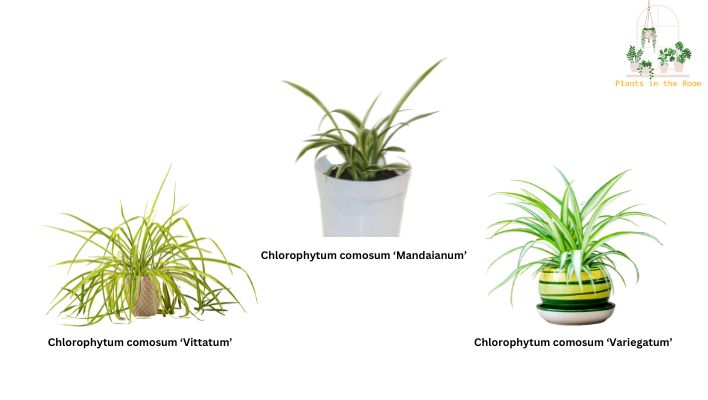
The Spider Plant, also known as Chlorophytum comosum, is a perennial favorite among houseplant enthusiasts and interior decorators worldwide. With their long, arching foliage and fascinating growth habits, Spider Plants effortlessly bring a touch of natural beauty to any indoor space.
In this section, we will delve into the origins and characteristics of Spider Plants and examine their myriad health and environmental benefits.
What are Spider Plants?
Spider Plants are widely admired for their unique form and incredible adaptability. Their natural home is the tropical and southern regions of Africa, but these resilient plants have found their way into homes around the globe. There’s more to these plants than meets the eye, and understanding their unique features can help you appreciate them more and give them the care they need to thrive.
1. The Growth Pattern and Physical Appearance of Spider Plants
One of the standout features of Spider Plants is their distinct growth pattern. They boast an attractive rosette of long, slender leaves that grow from the center of the plant and arch outwards. The leaves are a vibrant green, often marked with a creamy white stripe down the middle.
As the plant matures, it produces offshoots or “spiderettes,” that dangle from the mother plant like spiders on a web, hence the common name ‘Spider Plant’.
2. Spider Plants and Indoor Adaptability
The ability of Spider Plants to adapt to indoor conditions is nothing short of remarkable. They can grow in a range of light conditions, from bright indirect light to semi-shade, and can tolerate temperatures typically found in homes. Their resilience and low-maintenance nature make them a favorite among beginners and experienced plant owners alike.
Benefits of Spider Plants
While the Spider Plant’s beauty is apparent, it is also a silent workhorse that confers numerous health benefits. Let’s delve deeper into the beneficial characteristics of these amazing plants.
1. Air Purification Abilities
Spider Plants are not just decorative; they are also functional. They have the impressive ability to purify the air by absorbing toxins such as formaldehyde and xylene. These toxins are commonly found in homes and offices, emitted by items like furniture, carpets, and electronic devices.
By absorbing these harmful compounds, Spider Plants contribute to a healthier and cleaner indoor environment.
2. Safety for Children and Pets
While many houseplants can be toxic to pets and children if ingested, Spider Plants are a notable exception. They are non-toxic and safe to have around curious pets or toddlers, providing peace of mind for homeowners.
3. Health and Wellness Benefits
In addition to improving air quality and being safe for the entire family, Spider Plants are also associated with promoting well-being. Their vibrant green foliage can contribute to a calming and relaxing atmosphere, potentially reducing stress and boosting mood. They also increase humidity in indoor spaces, which can be beneficial in dry climates or during winter months.
Different Varieties of Spider Plants
There are several varieties of Spider Plants, each with its unique visual appeal.
- Chlorophytum comosum ‘Vittatum’: This variety features a bold white stripe down the center of each leaf. The contrasting green and white make it a striking addition to your decor.
- Chlorophytum comosum ‘Variegatum’: The leaf pattern is reversed; the leaves are primarily white with green edges. This variety is slightly slower growing but equally beautiful.
- Chlorophytum comosum ‘Mandaianum’: Commonly known as the ‘Dwarf Spider Plant’, it has a smaller growth habit, making it perfect for tight spaces or as a desk plant.
Understanding these different varieties can help you choose the one that best suits your personal aesthetic and space requirements.
Decorative Ideas Using Spider Plants
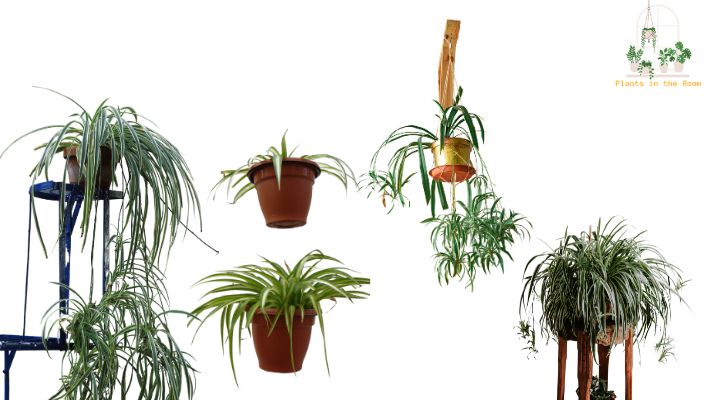
With their vibrant green foliage and unique growth pattern, Spider Plants is an excellent addition to your indoor plant collection and an extraordinary decor element. There are various innovative and beautiful ways to incorporate these plants into your home decor, enhancing the aesthetics of your space while purifying the air. This section will explore popular and stylish ways to display Spider Plants, including hanging baskets, shelf displays, and table centerpieces.
1. Hanging Baskets
Hanging Spider Plants can turn a bland room corner into a mini tropical paradise. Their captivating aesthetics coupled with an easy-care routine make them an ideal choice for busy homeowners looking to enhance their living spaces. Here’s more on how you can best use Spider Plants in hanging baskets.
Why Use Hanging Baskets?
The unique growth pattern of Spider Plants lends itself perfectly to hanging baskets. As the plant matures, it produces long, arching leaves and trailing spiderettes that cascade down beautifully, creating an eye-catching display. Their dangling spiderettes give a sense of movement, adding dynamic elements to your home decor.
In addition, hanging baskets allow for more efficient use of space, especially in smaller homes or apartments where floor space might be limited. They also place the plants at eye level, making their intricate details more noticeable and enjoyable.
Where to Hang Your Spider Plant Baskets?
The location of your hanging baskets can significantly affect the health and appearance of your Spider Plants. While they’re adaptable to a variety of light conditions, they prefer bright, indirect sunlight. Therefore, hanging them near a north or east-facing window would be ideal. However, they should be kept away from direct sunlight to prevent leaf burn.
Other popular spots for hanging Spider Plant baskets include corners of rooms, above kitchen counters, or near a reading nook. Wherever you place them, ensure the location allows the spiderettes to grow and dangle freely, without interference.
Basket Styles and Varieties
The basket you choose for your Spider Plant can greatly influence the overall decor aesthetics. Here are a few popular options:
- Woven Baskets: These offer a rustic, homey look and can complement boho-chic or farmhouse-style interiors.
- Ceramic Pots: A hanging ceramic pot can provide a more refined, clean-lined aesthetic. These work well in modern or minimalist spaces.
- Glass Terrariums: Consider hanging your Spider Plants in glass terrariums for a contemporary and unique look. These allow you to see the plant from all angles, including interesting root structures.
Using Spider Plants in hanging baskets is an excellent decor strategy that combines aesthetics, functionality, and plant health. It’s a simple yet impactful way to liven up your living space, bringing the tranquility and beauty of nature indoors.
2. Shelf Display
The idea of a ‘green’ shelf is becoming increasingly popular among interior design enthusiasts and plant lovers. Including Spider Plants in your shelf displays is an innovative way to create a serene, nature-infused space. By creating a ‘green library,’ you not only enhance the aesthetic appeal of your room but also benefit from the air-purifying qualities of these plants. Here’s how you can achieve it using Spider Plants.
Creating a Green Library
Designing a green library with Spider Plants can make your reading or work area lively and inviting. Their arching foliage and cascading spiderettes offer a visually appealing contrast to the straight lines of books or other items on your shelf.
When arranging Spider Plants on your shelves, ensure the plants have ample space to grow. Ideally, placing them on a higher shelf or near the edge where their spiderettes can grow and dangle freely creates a beautiful green curtain.
In addition, you can play around with pot designs and colors to match your room’s decor. Using geometric pots or vibrant colors can add an extra layer of interest to your green library.
Shelf Display Considerations
Location is crucial when setting up your green library. Here are a few considerations:
- Light: Spider Plants prefer bright, indirect light. If your shelf is near a window that gets direct sunlight, consider using a sheer curtain to filter the light. While Spider Plants can tolerate low light conditions, their growth may be slower.
- Humidity: Spider Plants enjoy moderate humidity. If your room is dry, consider placing a small humidifier nearby or grouping your plants together to increase humidity levels.
- Accessibility: Ensure the shelf is easy to access for watering and care tasks. Additionally, ensure the Spider Plants are placed securely and won’t be easily knocked over.
Integrating Spider Plants into your shelf displays provides a lush, calming atmosphere and adds personality and character to your space. With a little creativity, you can transform your regular shelves into captivating green displays that are a delight to behold.
3. Table Centerpieces
Spider Plants can be a fantastic and low-maintenance alternative to traditional flower centerpieces. With their lush, arching foliage and interesting growth pattern, they can make a captivating centerpiece for any table.
Whether it’s a dining table, a coffee table, or even a study desk, a well-placed Spider Plant can breathe life into the space. Let’s look at how you can use them to liven up your tables.
Enhancing Dining and Coffee Tables
In the dining area, a Spider Plant centerpiece can create a relaxed and refreshing atmosphere. Their verdant leaves complement a wide range of table settings, whether a casual family meal or a formal dinner. Their air-purifying abilities can improve the indoor air quality where you dine, contributing to a healthier living environment.
Similarly, placing a Spider Plant on your coffee table can elevate the aesthetics of your living room. This can make your relaxation or social area more inviting. Their lively presence can stimulate interesting conversations about your love for plants and nature with guests.
Choosing the Right Pot
When using Spider Plants as table centerpieces, the choice of the pot is nearly as important as the plant itself. The pot can complement your decor and highlight the beauty of the Spider Plant. Here are a few pot styles to consider:
- Ceramic Pots: Sleek and stylish ceramic pots can lend a modern, elegant touch to your table centerpiece. You can choose a pot that matches your room’s color scheme or a contrasting color for a bold statement.
- Terracotta Pots: Terracotta pots are a fantastic choice for a more rustic or traditional look. Their warm, earthy tones contrast beautifully with the Spider Plant’s vibrant green leaves.
- Designer Pots: For a unique, artistic touch, consider designer pots. These can feature intricate patterns, bold colors, or unusual shapes, turning your plant centerpiece into a piece of art.
- Self-Watering Pots: For a low-maintenance centerpiece, you might want to consider self-watering pots. These pots have a reservoir that provides water to the plants as needed, perfect for those who may forget to water regularly.
Remember, the pot should be large enough to accommodate the growth of the plant but not so large that it overwhelms your table.
Spider Plants can be a striking, low-maintenance centerpiece for any table. Their delightful aesthetics and air-purifying abilities bring beauty and health benefits to your indoor spaces. They can be a real conversation starter with the right pot, reflecting your unique style and love for nature.
Care for Your Spider Plant
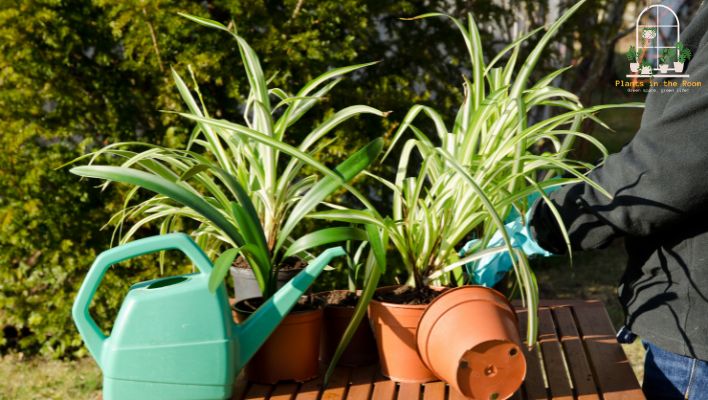
As you add Spider Plants to your indoor space and admire their aesthetic appeal, ensuring they receive the right care is essential. While these plants are known for their hardiness and adaptability, understanding and providing for their specific needs can help them thrive and grow. In this section, we’ll delve into the specifics of Spider Plant care, discussing light and temperature requirements, watering and fertilization techniques, as well as pruning and repotting methods.
Light and Temperature
Like most indoor plants, Spider Plants have specific light and temperature requirements that need to be met to ensure their optimal growth and health.
Ideal Lighting Conditions for Spider Plants
Spider Plants prefer bright, indirect sunlight. They can tolerate low light conditions, but their growth may be slower. Beware of direct sunlight, especially during the intense midday hours, as it can scorch their leaves, leading to brown tips or spots. Placing them near north or east-facing windows is typically a good option.
Temperature Requirements
Spider Plants are quite tolerant when it comes to temperature. They thrive in typical indoor temperatures ranging between 60-75°F (15-24°C). However, they don’t appreciate cold drafts or temperatures below 50°F (10°C). So, try to keep them away from drafty windows or doors during the winter months.
Water and Fertilization
Proper watering and fertilization are critical aspects of plant care. Let’s look at the best practices for watering and fertilizing your Spider Plant.
Watering Your Spider Plant
Spider Plants prefer their soil to dry out slightly between watering. Therefore, it’s best to water them when the top inch of the soil feels dry to the touch. However, ensure they are not left bone dry for prolonged periods. Overwatering can lead to root rot, a common issue in houseplants. So, it’s better to err on the side of underwatering.
Fertilizing Your Spider Plant
While Spider Plants are not heavy feeders, they do appreciate a little boost during their growing season. Feeding them with a half-strength houseplant fertilizer once a month during the spring and summer months will keep them happy. Remember to water the plant thoroughly before applying fertilizer to prevent root burn.
Pruning and Repotting
Regular pruning and timely repotting can keep your Spider Plant looking its best and ensure its healthy growth.
Pruning Your Spider Plant
Occasionally, Spider Plants may develop brown tips or dead leaves. This is usually due to low humidity, over-fertilization, or exposure to fluoride in tap water. Regular pruning helps the plant maintain its attractive appearance. Use a pair of clean, sharp scissors to cut off the brown parts, following the natural shape of the leaf.
Repotting Your Spider Plant
Spider Plants are fast growers and can quickly become pot-bound. Generally, it’s a good idea to repot them every couple of years or when you see roots growing out of the drainage hole. Choose a pot that’s only slightly larger than the current one, as a too-large pot can lead to overwatering issues.
By following these care tips, you can ensure that your Spider Plants stay healthy and beautiful, enhancing your home’s decor for years to come.
In Conclusion
Spider Plants offer an unparalleled blend of aesthetics, ease of care, and health benefits, making them a popular choice for home decor. Whether you’re a seasoned indoor gardener or a newbie, these plants are an excellent addition to your indoor space.
By understanding their needs and applying the decor ideas mentioned in this guide, you can create a beautiful, healthy, and inviting indoor environment. Remember, the key to successful plant decor is not just about placing the plant; it’s about creating a space where both you and the plant can thrive.

